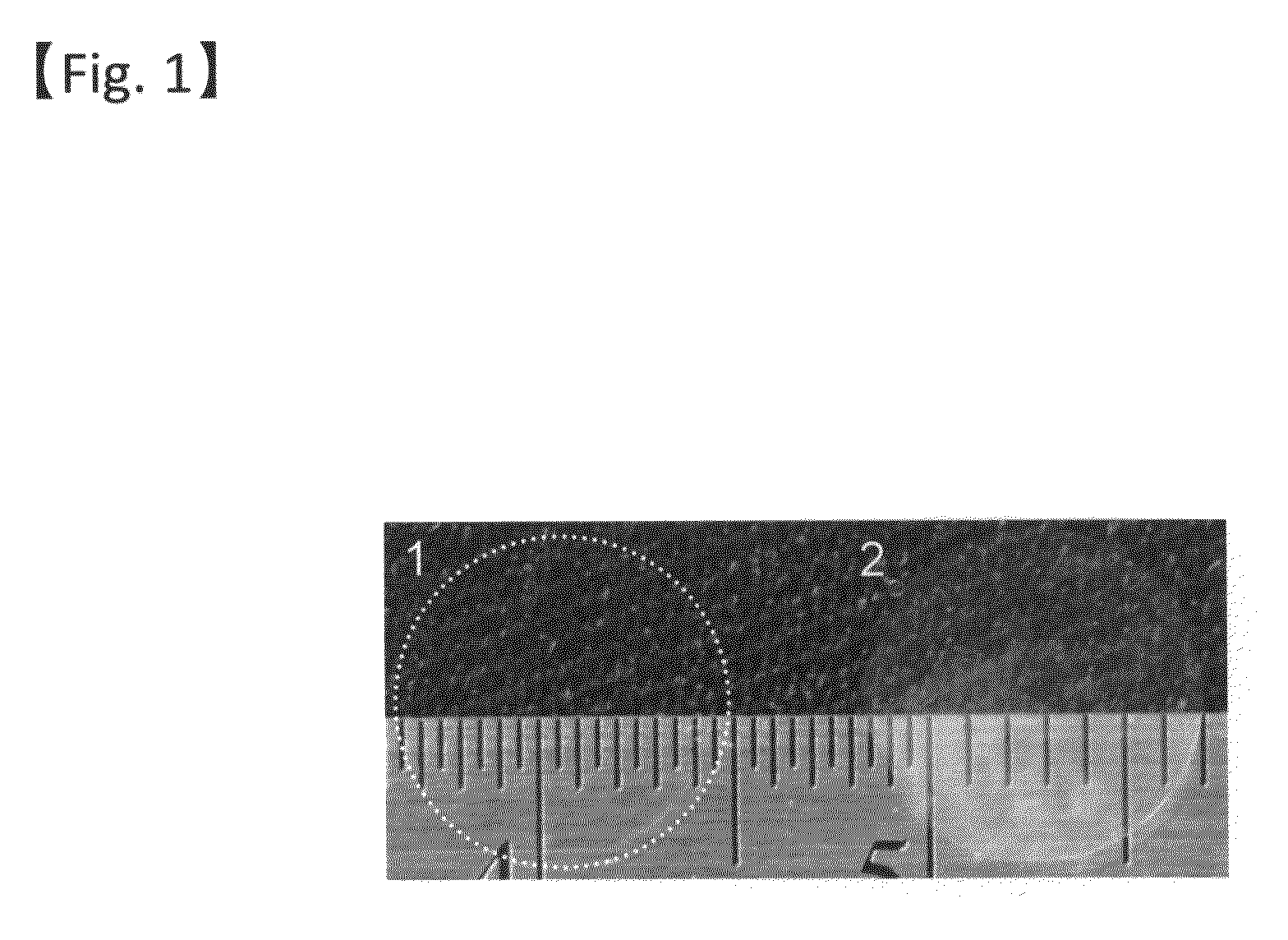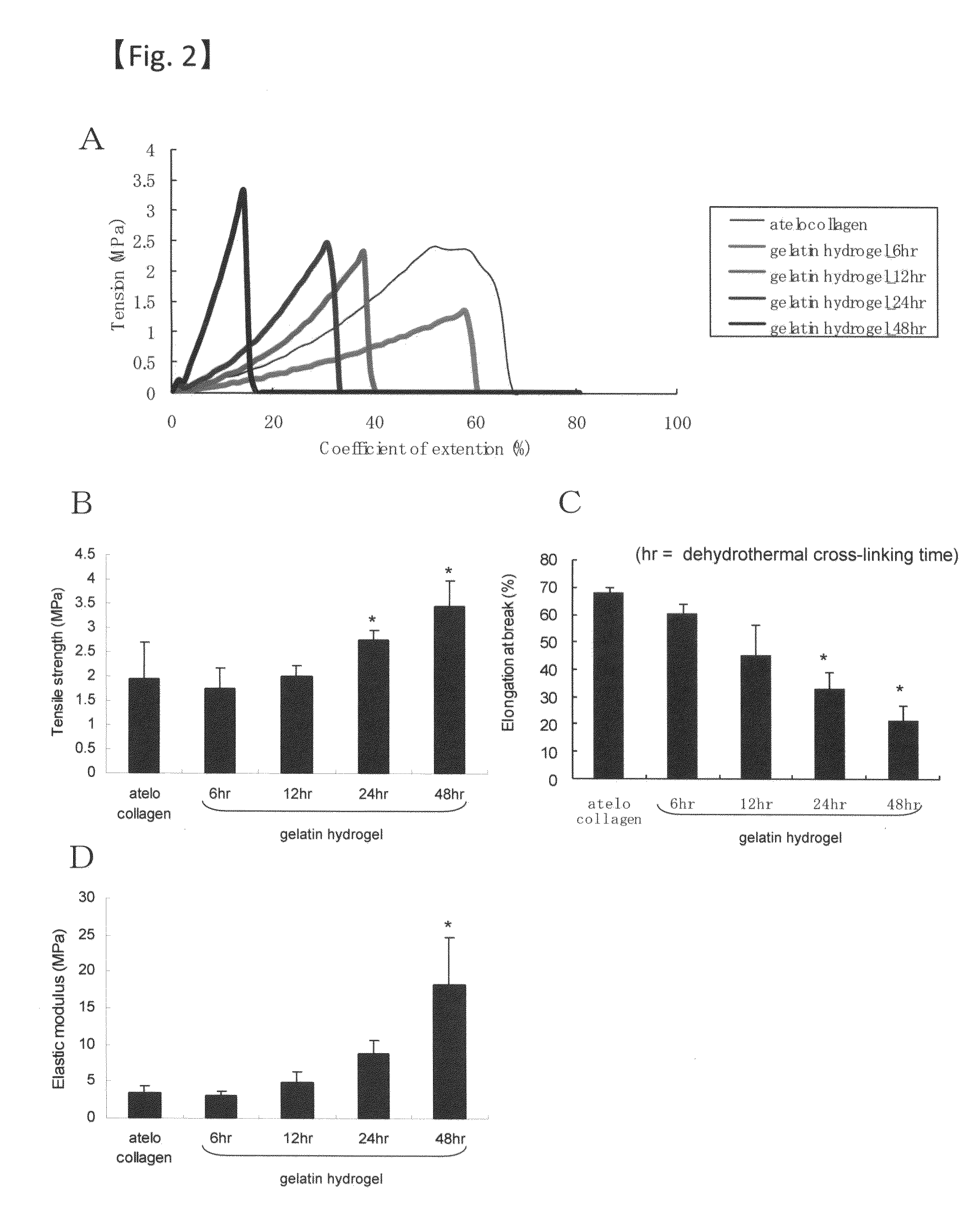Sheet for corneal transplants
a sheet and corneal technology, applied in the field of sheet for corneal transplants, can solve the problems of corneal endothelial disease such as corneal opacity and bullous keratopathy, reduce the number of transplanted cells, and insufficient water discharge, etc., to achieve stable transplantation results, appropriate strength, and easy handling of cells during transplantation
- Summary
- Abstract
- Description
- Claims
- Application Information
AI Technical Summary
Benefits of technology
Problems solved by technology
Method used
Image
Examples
example 1
Preparation of the Gelatin Hydrogel Sheet
[0080]Collagen was extracted from pig skin or cattle bone by alkali treatment (molecular weight: 98,000, isoelectric point: 5.0). Then, a 10 WT % aqueous solution of gelatin was adjusted. This solution was poured into a plastic petri dish and left for several days at room temperature to evaporate water, whereby a gelatin sheet was obtained. The gelatin sheet was then subjected to thermal dehydration treatment at 160° C. and 0.01 Torr for 72 hours to chemically cross-link the gelatin molecules. The gelatin sheet thus obtained had a percentage water content of 97% and a thickness of 100 μm. It should be noted that thickness can be adjusted to 30 μm or more depending on the purpose.
(1) Transparency
[0081]The gelatin hydrogel sheet prepared as above (48 hours of cross-linking) and an atelocollagen sheet (KOKEN CO., LTD.) were visually compared for transparency (FIG. 1). Further, the light transmittance was compared among the gelatin hydrogel sheet...
example 2
Cell Culture on the Gelatin Hydrogel Sheet
1. Preparation of Corneal Endothelial Cells
[0087]Corneoscleral buttons were prepared from the rabbit eye and the Descemet's membrane was detached. The Descemet's membrane was incubated with 0.25% Trypsin-EDTA at 37° C. for 10 minutes to isolate cells. To the cells, a DMEM medium (low glucose, Nikken Bio Medical Laboratory) containing 2 ng / ml bFGF (R&D systems, Inc.) and 10% serum (Japan bio serum) was added, followed by centrifugation at 300 g for five minutes. The supernatant was aspirated and the remaining cell aggregate was suspended in the same medium.
2. Study on the Corneal Endothelial Cell Culture and the Coating Conditions
[0088]The gelatin hydrogel sheet prepared in Example 1 was coated with type I or type IV collagen (Nitta Gelatin, Inc.). As the coating method, a method of directly applying a 3.0 mg / ml collagen stock solution (pH 3.0) on the gelatin hydrogel sheet prepared in Example 1 with a cell scraper and the like and a method o...
example 3
Transplantation of the Gelatin Hydrogel Sheet into the Rabbit Anterior Chamber (Study on Biodegradability)
[0093]Following cataract extraction from the rabbit eye (phacoemulsification), the Descemet's membrane was detached. Then, a gelatin hydrogel sheet punched out with an 8 mm trepan was transplanted alone into the anterior chamber.
(1) Observation Image of the Ocular Surface
[0094]As of 28th day after transplantation, transparency of the sheet transplanted into the anterior chamber and transparency of the cornea were both maintained and the iris could be seen through. Also, there was no sign of inflammation, edema, or the like.
(2) The Gelatin Hydrogel Sheet after Transplantation The rabbit was euthanized on postoperative day 28, and the eye ball was taken out and chemically fixed with a 10% neutral buffered formalin solution. Subsequently, the corneal tissue was observed with hematoxylin and eosin staining (FIG. 7 (a) before transplantation, (b) after transplantation). The cornea ti...
PUM
| Property | Measurement | Unit |
|---|---|---|
| Time | aaaaa | aaaaa |
| Thickness | aaaaa | aaaaa |
| Thickness | aaaaa | aaaaa |
Abstract
Description
Claims
Application Information
 Login to View More
Login to View More - R&D
- Intellectual Property
- Life Sciences
- Materials
- Tech Scout
- Unparalleled Data Quality
- Higher Quality Content
- 60% Fewer Hallucinations
Browse by: Latest US Patents, China's latest patents, Technical Efficacy Thesaurus, Application Domain, Technology Topic, Popular Technical Reports.
© 2025 PatSnap. All rights reserved.Legal|Privacy policy|Modern Slavery Act Transparency Statement|Sitemap|About US| Contact US: help@patsnap.com



